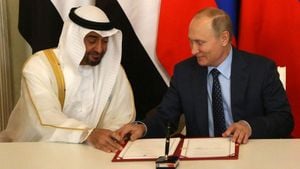The decline of minority languages in India raises alarm bells for cultural preservation, with specific challenges facing Kashmiri and Punjabi speakers. Once thriving languages, both now struggle for existence amid urbanization, globalization, and inadequate government support.
Kashmiri, known as 'Koshur' among its speakers, is more than just a means of communication; it is the lifeblood of the cultural identity of the Kashmir Valley. Its rich heritage, influenced by Sanskrit, Persian, and Arabic, has long made it the medium for literary expression. Yet, its speakers, particularly among the younger generation, are dwindling. Urban migration sees families opting for languages like Urdu and English, creating a significant shift away from everyday conversations in Kashmiri. This trend threatens the intergenerational transmission of the language, weakening the social fabric of families.
According to Brighter Kashmir, the erosion of family conversations and cultural rituals is evident as language shifts. Children increasingly find themselves incapable of conversing fluently in their mother tongue, leading to the gradual loss of authentic Kashmiri cultural expressions.
While Kashmiri was officially recognized as a language by the Jammu and Kashmir Union Territory government in 2020, this status remains largely symbolic. The lack of governmental initiatives to promote its use across educational and media platforms has resulted in increased marginalization of the language compared to more dominant tongues. "The lack of funding for language preservation has led to the sidelining of Kashmiri, leaving it vulnerable to extinction," said one cultural advocate featured by Brighter Kashmir.
Globalization adds another layer of complexity to this linguistic crisis. The proliferation of English and Hindi as dominant languages across media channels has confined Kashmiri content to niche markets, often limiting its appeal to younger audiences who prefer modern online content primarily available only in Hindi or English. This cultural shift not only risks the survival of Kashmiri but causes significant cultural erosion.
The decline of Punjabi mirrors these issues, particularly among urban Punjabi Hindus. While recognized as the official language of the Indian state of Punjab, Punjabi is losing its foothold to Hindi, which many among the younger generation equate with national identity—often citing, “Kyunki main Indian hoon” (Because I am Indian). This sentiment was echoed by Nishtha Sood, who detailed her experiences of growing up as Punjabi Hindu amid the dominance of Hindi culture.
Despite Punjabi holding historical significance, particularly within cultural practices linked to celebrations and rituals, there exists widespread neglect of the language among the elite classes. Reports indicate urban Punjabi families now prefer Hindi, and cultural pride expressed through traditional festivities is often overshadowed by the practical use of Hindi for daily interactions. “When people abandon their language, they lose their soul as well,” wrote renowned scholar Rasul Gamzatov, capturing the essence of this loss.
Socio-political dynamics also play a role. The protests against perceived injustices faced by non-Hindi speakers brought language back to the forefront of political discussion. Recent exchanges within the Uttar Pradesh Assembly unfolded tensions over the inclusion of Urdu as the official language for Assembly translations. Opponents argue it undermines the struggle against the imposition of English, which has long been cited as detrimental to regional languages.
The Leader of the Opposition, Mata Prasad Pandey, stated, “If UP does not promote Urdu, then who will?” His calls for inclusivity across languages highlight the intertwined fates of Hindi, Urdu, and other regional languages. The need for representation transcends minimal political acknowledgment, demanding genuine integration and encouragement of linguistic diversity.
Community and grassroots efforts are also necessary for encouraging minority languages. Leaders assert the importance of revitalization through education and media, which requires governmental involvement. There's hope for creation of digital platforms for Kashmiri and Punjabi, enabling younger learners to engage with their languages effortlessly. Such initiatives can restore pride among community members and assert cultural identity against the tidal wave of homogenization.
This is where International Mother Language Day, celebrated every February 21st, becomes significant. It reminds society of the importance of preserving mother tongues. English and Hindi might dominate mainstream narratives, but the essence of cultural identities lies embedded within languages like Kashmiri and Punjabi. The time has come for concerted action—not just once annually, but on continuous fronts—to advocate for these languages.
Speakers of Kashmiri and Punjabi alike urgently call for comprehensive policy changes aimed at making these languages relevant not just academically but socially and culturally. Languages are repositories of history; their decline signals loss of unique identities for countless communities.
Promoting Kashmiri as part of school curricula or adapting media to feature more content reflects the cultural resonance of these languages. The implication for the future extends beyond vocabulary; it concerns identity, cohesiveness, and survival of diverse legacies for generations to come.
Government support coupled with community engagement can reverse decades of marginalization. Therein lies hope: by fostering pride and practical use of these minority languages, societies can reclaim not only cultural significance but also the very essence of their identities. A living language continues to bind its speakers to their roots, heritage, and each other.



